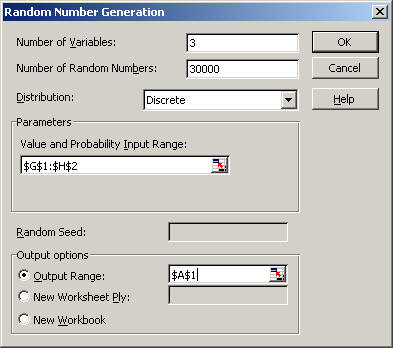ISP 121 Activity 6
1. Classify each of the following statements as an example of theoretical
probability, relative frequency interpretation of probability, or personal
(subjective) probability.
a. On the basis of prior counts, a quality control engineer says that there
is a 0.005 probability that a vacuum hose is defective.
b. The probability that I will get the flu this winter is 30%.
c. The probability of selecting five card of the same suit (a flush) from a
standard deck of cards is 0.00005.
d. The chance that a randomly selected person in the United States is between
15 and 24 years old is 0.14.
e. The probability that General Electric's stock price will rise today is
75%.
2. The following questions are based the experiment of
tossing three coins.
a. Describe the sample space (set of possible outcomes) for the experiment
of tossing three coins.
b. Using the sample space, calculate the theoretical probability that you get 2 heads and
1 tail.
c. What the probability of getting three heads?
d. What is the probability of getting at least one tail?
e. Use Excel to simulate question b with 30000 trials. Out of how many
trials do you get 2 heads and 1 tail? How close is the relative frequency
of the event in the 30000 trials to the theoretical probability?
(Hint. Simulate 3 columns of data, using 1 for heads and 0 for tail.
Then in column D add up each row (use =SUM(...) or =A1 +B1+ C1). The sum will be how many heads you get. Finally use COUNTIF
on column D.)

3. Three people (John, Marvin, and Tom) carry similar
looking umbrellas when they arrive at restaurant. They leave the umbrellas
in small coat room in the restaurant, and when each leaves, he randomly takes
one of the three similar looking umbrellas.
a. Describe the sample space (the set of possible outcomes)
for this experiment.
b. Using the sample space, calculate the probability that
all three people end up with an umbrella that is not their own.
4. Open file,
Drug Test.xls.
In a test of the effectiveness of an allergy drug, some people were given the
drug, some were given a placebo, and a control group was given no treatment.
In the empty cells, enter formulas to calculate the totals then answer the
questions below.
- What is the probability that a randomly selected
person in the study was given either the drug or a placebo?
- What is the probability that a randomly selected
person either improved or did not improve?
- What is the probability that a randomly selected
person either was given the drug or improved?
- What is the probability that a randomly selected
person was given the drug and improved?
5. The following questions are based the
experiment of rolling two dice.
a. What is the probability of getting a sum of 7 on a roll of two dice?
b. What is the probability of getting a 4 on a roll of two
dice?
6. A small business performs a service and then bills its
customers. From past experience, 90% of the customers pay their bills
within two weeks.
a. What is the probability that a randomly selected
customer will not pay within two weeks.
b. The business has billed two customers this week.
What is the probability that neither of them will pay within two weeks?
7. Suppose that 10% of the students at a particular college
are have a cold.
-
What is the probability that a student does not
encounter a person with a cold until the sixth person?
-
What is the probability that exactly one of the six people
encountered in an hour has a cold?
-
If a student encounters 6 people in an hour, what is
the probability that at least one of these people has a cold?
